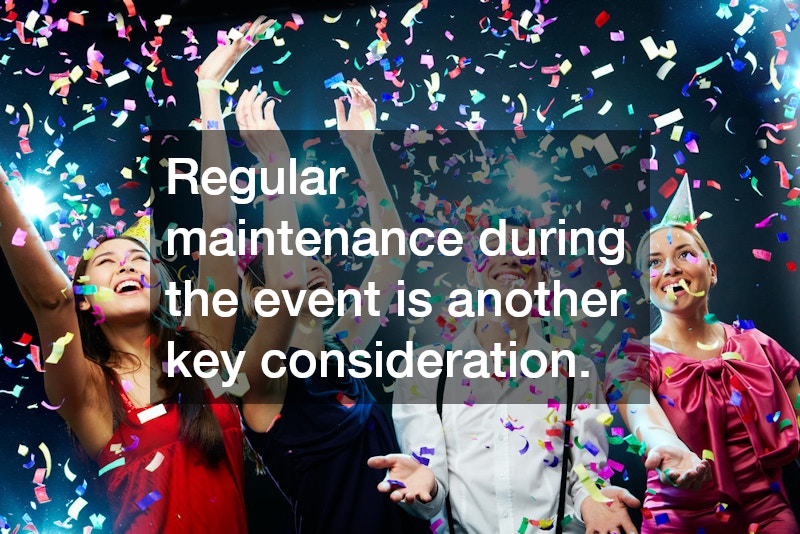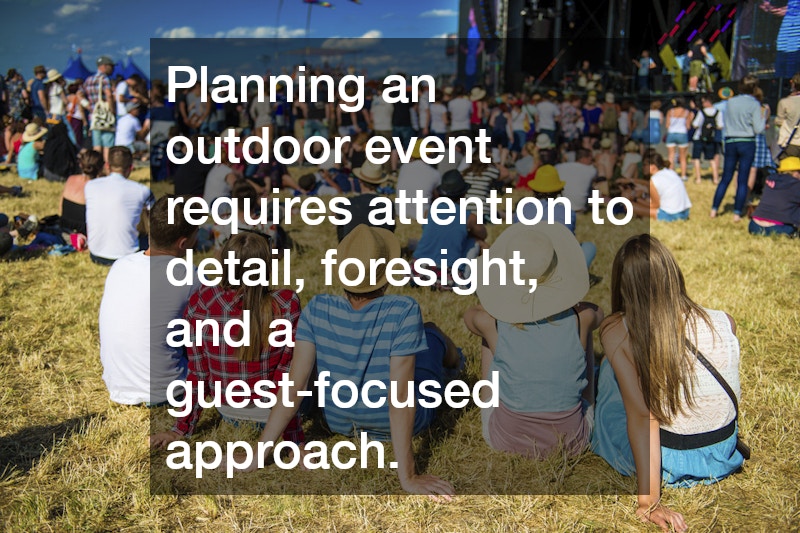Planning an outdoor event can be both exciting and challenging. Unlike indoor venues, outdoor locations require careful attention to factors such as weather, accessibility, and amenities. Whether you’re organizing a wedding, birthday party, corporate event, or community festival, guest comfort should be a top priority. Guests are more likely to enjoy themselves and remember the experience positively when they feel comfortable, safe, and cared for. From restrooms and seating to food, transportation, and entertainment, every detail counts.
This guide provides actionable tips to ensure that your outdoor event is not only memorable but also stress-free for both you and your guests.

Select the Right Venue for Guest Convenience
Choosing the right location sets the tone for the entire event. Guest comfort starts with accessibility, safety, and a layout that supports your planned activities. When evaluating potential outdoor venues, keep the following factors in mind:
Accessibility: Choose a site that’s easy for everyone to reach, including guests with mobility challenges. Check parking availability, pathways, and proximity to public transportation if needed. For larger events, consider arranging shuttle services from central locations or hotels to make travel easier for attendees. Additionally, ensure the entrance and exit points are clearly marked to avoid confusion. Accessibility also includes restroom locations and easy access to emergency services if necessary.
Terrain and safety: Uneven or rocky ground can pose risks. Ensure walkways are clearly marked and stable enough for walking, seating, and equipment setup. If your venue has grassy or sandy areas, consider providing temporary flooring or mats to make movement safer and more comfortable. Lighting is another key aspect—especially for evening events—so pathways and common areas should be well-lit to prevent accidents.
Shade and shelter: Whether through natural trees or added structures, shade is essential for comfort. Include tents, umbrellas, or covered areas to offer relief from sun exposure or unexpected rain. Fans or misting stations can also help guests stay cool during warmer months. For longer events, having multiple shaded areas encourages guests to mingle, relax, and stay hydrated without feeling exposed to the elements.
Proximity to attractions or services: Some events benefit from being near restaurants, hotels, or scenic areas. Nearby amenities can make the experience more enjoyable and convenient for guests. For example, hosting a picnic at a park near a lake might allow attendees to enjoy both the event and recreational activities. If your event requires catering or rental equipment, choosing a location close to service providers can simplify logistics and reduce setup costs.
For instance, a Florida beach venue offers beautiful views and a relaxed vibe, but it also requires careful planning—such as providing sand-friendly seating, ample sun protection, and accessible paths to the parking area or shoreline. Similarly, hosting a garden wedding in spring may require temporary walkways to protect delicate flowerbeds while keeping guests comfortable. Ultimately, selecting the right location is about finding the balance between aesthetics, convenience, and guest comfort so everyone enjoys the experience from the moment they arrive. By carefully evaluating accessibility, safety, shelter, and nearby services, event planners can create a welcoming environment that ensures a memorable and stress-free experience for every guest.
Plan for Comfortable and Accessible Restroom Facilities
Outdoor events often face challenges when it comes to restrooms. Unlike indoor venues, permanent facilities may be limited or nonexistent, making careful planning essential to maintain guest comfort and satisfaction.
Investing in a porta potty or upgraded portable toilet rentals can make a significant difference. Estimate the number of units needed: As a general guideline, provide at least one toilet per fifty guests for events lasting up to four hours. For longer events, or gatherings with a higher proportion of female attendees, additional units are recommended to prevent long lines and maintain convenience.
Choose quality over quantity. A premium porta potty offers features that enhance both comfort and hygiene, such as running water, hand sanitizer, proper ventilation, and a spacious interior. Some even include lighting for evening events or ADA-compliant units to ensure accessibility for all guests. These upgrades may cost more, but they greatly enhance the overall guest experience and leave a positive impression.
Placement matters. Position restroom units in areas that are easily accessible yet discreet, away from the main activity zones. Ensure the ground is level, pathways are clear, and signage is visible from a distance. For large venues, multiple units spaced throughout the site reduce travel time and make facilities convenient for everyone. Using a porta potty with additional features for high-traffic areas can further improve accessibility and guest satisfaction.
Regular maintenance during the event is another key consideration. A professional service can handle routine cleaning and restocking, preventing unpleasant odors or sanitation issues. For multi-day events, plan scheduled maintenance checks to keep facilities fresh and functional. Consider providing handwashing stations, disposable towels, or hand sanitizer at each unit to reinforce hygiene.
Additionally, consider the overall aesthetics and guest comfort. Portable toilets can be screened with decorative fencing or natural barriers like shrubs, maintaining the visual appeal of your venue without sacrificing accessibility. By proactively planning restroom facilities, you ensure guests stay comfortable, satisfied, and focused on enjoying the event rather than worrying about basic necessities. Properly maintained and thoughtfully placed facilities are an essential element of any successful outdoor gathering, contributing to a seamless and enjoyable experience from start to finish.

Manage Waste Efficiently During the Event
Guest comfort extends beyond seating and restrooms to cleanliness and waste management. A tidy, well-organized venue prevents unpleasant odors, clutter, and potential hazards, making the event more enjoyable for everyone. Proper planning for trash disposal also reduces stress for event staff and helps maintain a professional appearance throughout the day.
For larger gatherings, hiring professional dumpster rental services ensures that waste is collected efficiently and kept out of sight. Calculate the amount of waste expected. Consider all sources of trash, including food, beverage containers, packaging, decorations, and promotional materials. Estimating accurately helps determine the number and size of dumpsters needed to prevent overflow and maintain a clean environment.
Provide clear signage. Guests are more likely to use bins correctly when they are labeled clearly for recyclables, compost, and general waste. Color-coded bins or bold icons can help attendees quickly identify the proper disposal method, reducing confusion and keeping the venue orderly. Educating staff or volunteers to monitor and empty bins periodically also ensures that receptacles do not become overfilled.
Strategic placement is equally important. Position dumpsters and waste stations in discreet but accessible locations, such as near service areas, food stations, or behind temporary screens. This keeps them out of main sightlines while remaining convenient for guests. For sprawling outdoor venues, multiple stations spread throughout the property can reduce the likelihood of litter and encourage proper disposal.
Schedule timely pickup with the rental company. Depending on the event’s duration, coordinate pickups during or immediately after the gathering to maintain cleanliness. For multi-day events, plan for regular checks and emptying schedules to keep the site looking organized and welcoming.
Maintaining a clean and well-managed venue not only enhances comfort but also demonstrates thoughtful planning and attention to detail. Guests are more likely to feel relaxed and engaged when they are surrounded by a safe, tidy, and organized environment. Proper waste management contributes to the overall success of the event, ensuring that attendees remember a seamless, enjoyable experience rather than distractions caused by clutter or odor.
Maintain Sanitation Between Uses
For events in remote locations or private properties, maintaining sanitation requires more than just portable toilets. Booking septic pumping services in advance ensures that facilities remain functional and hygienic throughout multi-day or high-traffic events.
Here are some best practices:
-
Monitor usage: Assign staff to check restrooms periodically, replenishing supplies like toilet paper and hand sanitizer.
-
Professional cleaning: For multi-day events, professional staff can perform cleaning, disposal, and refills as needed.
-
Emergency preparedness: Have contingency plans in case of overflows or breakdowns. Extra restroom units or backup pumping services can prevent guest discomfort.
Maintaining a high level of sanitation demonstrates attention to detail and prioritizes guest well-being, allowing them to relax and enjoy the event.

Provide Comfortable Seating and Shelter Options
Seating and shelter directly impact how long guests can comfortably enjoy an outdoor event. Exposure to sun, wind, or rain can quickly become a problem without proper planning.
Consider these practical strategies:
-
Tents and canopies: These provide shade and shelter from unexpected weather. Use waterproof materials for rainy conditions and open-sided designs to maintain airflow.
-
Flexible seating arrangements: Cluster seating into social groups or family sections to encourage interaction and make it easy for guests to move around.
-
Accessibility: Include seating that accommodates all guests, including those with mobility limitations. Ensure pathways to seating are smooth and unobstructed.
-
Comfort enhancements: Provide cushions, blankets, or lounge areas to enhance relaxation.
By prioritizing comfort in seating and shelter, hosts can encourage guests to stay longer and enjoy every aspect of the event.
Enhance the Dining Experience
Food and drink are central to most outdoor events. Proper setup ensures guests enjoy meals comfortably while minimizing stress for hosts and catering staff.
-
Buffet and serving stations: Position these in areas that minimize congestion, with clear lines and easy access for all guests.
-
Temperature control: Use coolers, chafing dishes, or warming stations to maintain food at safe and enjoyable temperatures.
-
Hydration stations: Provide plenty of water, especially in warm climates or during physical activities.
For events that combine indoor and outdoor spaces, banquet halls can serve as backup locations for dining or dessert areas. They provide climate control and additional seating options while complementing the outdoor ambiance.
Capture the Event Professionally
Photos preserve memories, and hiring a skilled photographer ensures that your event is documented beautifully, regardless of weather or lighting challenges.
Tips for planning photography include:
-
Scout the venue: Identify ideal photo spots, scenic backgrounds, and lighting conditions.
-
Coordinate with the schedule: Align photo sessions with key moments, such as speeches, ceremonies, or special activities.
-
Communicate with guests: Provide clear guidance on when and where to expect photos to avoid disruption.
Professional photography adds value by capturing candid moments, group shots, and detail photos that guests and hosts can treasure for years to come.
Plan Entertainment and Transportation Thoughtfully
A well-organized event ensures guests can move around comfortably and enjoy entertainment without stress. Transportation and travel logistics play a big role in this.
Partnering with local limo companies can provide stress-free arrivals and departures, particularly for VIP guests or large groups. Additional considerations include:
-
Drop-off and pickup points: Designate clear zones for shuttles, ride-sharing services, and private vehicles to prevent congestion.
-
Parking management: Ensure adequate spaces and safe pathways from parking areas to the event site.
-
Entertainment placement: Position stages, activity zones, or performance areas to maximize visibility while minimizing crowding or noise conflicts.
Planning transportation and entertainment with guest comfort in mind can greatly enhance the overall experience, making the event feel smooth and professionally managed.
Ensure a Smooth Arrival and Departure Experience
The beginning and end of an event set the tone for guest satisfaction. Efficient arrivals and departures reduce stress and prevent bottlenecks.
-
Signage and directions: Use clear signs to guide guests to entrances, restrooms, and key activity areas.
-
Check-in stations: Organize welcome tables or registration points to avoid long lines.
-
Waste management: Utilize dumpster rental for immediate cleanup after the event, ensuring pathways and communal areas remain clean and safe.
-
Staff assistance: Employ event staff or volunteers to direct guests and provide support as needed.
Smooth logistics contribute to a polished experience, leaving guests with a positive lasting impression.
Enhance Guest Comfort With Additional Amenities
Small touches can significantly improve the comfort of your attendees. Thoughtful amenities demonstrate care and attention to detail:
-
Climate control: Fans, heaters, or misting systems can mitigate extreme temperatures.
-
Refreshments: Water stations, light snacks, or beverage carts encourage guests to stay hydrated and energized.
-
Tech conveniences: Charging stations for devices and Wi-Fi access enhance connectivity for both guests and event staff.
-
Extra restroom options: High-traffic events benefit from multiple porta potties to minimize wait times.
Even seemingly minor considerations, like blankets for evening events or shaded lounge areas, contribute to a seamless and enjoyable experience for all attendees.
Planning an outdoor event requires attention to detail, foresight, and a guest-focused approach. By prioritizing comfort through thoughtful venue selection, sanitation, seating, food, transportation, and entertainment, hosts create an environment where guests can relax, socialize, and enjoy the experience fully. Proper planning not only ensures the event runs smoothly but also leaves a lasting impression that reflects professionalism and care. Taking the time to address logistics, amenities, and safety allows both hosts and attendees to focus on what truly matters: celebrating together. Additionally, anticipating potential challenges—such as weather changes, accessibility needs, or waste management—demonstrates foresight and enhances overall satisfaction. Small touches, from shaded seating areas to convenient restroom access and clear signage, contribute significantly to guest comfort and enjoyment. Thoughtful preparation ultimately transforms an outdoor gathering into a memorable, seamless experience that guests will appreciate long after the event concludes.

